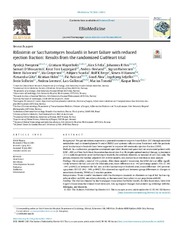Rifaximin or Saccharomyces boulardii in heart failure with reduced ejection fraction: Results from the randomized GutHeart trial
Permanent lenke
https://hdl.handle.net/10037/22149Dato
2021-07-28Type
Journal articleTidsskriftartikkel
Peer reviewed
Forfatter
Awoyemi, Ayodeji Olawale; Mayerhofer, Cristiane; Felix, Alex S.; Hov, Johannes Espolin Roksund; Moscavitch, Samuel D.; Lappegård, Knut Tore; Hovland, Anders; Halvorsen, Sigrun; Halvorsen, Bente; Gregersen, Ida; Svardal, Asbjørn M.; Berge, Rolf Kristian; Hansen, Simen Hyll; Götz, Alexandra; Holm, Kristian; Aukrust, Pål; Åkra, Sissel; Seljeflot, Ingebjørg; Solheim, Svein; Lorenzo, Andrea; Gullestad, Lars; Trøseid, Marius; Broch, KasparSammendrag
Methods - In a multicentre, prospective randomized open label, blinded end-point trial, we randomized patients with LVEF <40% and New York Heart Association functional class II or III, despite optimal medical therapy, to treatment (1:1:1) with the probiotic yeast Saccharomyces boulardii, the antibiotic rifaximin, or standard of care (SoC) only. The primary endpoint, the baseline-adjusted LVEF at three months, was assessed in an intention-to-treat analysis.
Findings - We enrolled a total of 151 patients. After three months’ treatment, the LVEF did not differ significantly between the SoC arm and the rifaximin arm (mean difference was -1•2 percentage points; 95% CI -3•2 - 0•7; p=0•22) or between the SoC arm and the Saccharomyces boulardii arm (mean difference -0•2 percentage points; 95% CI -2•2 - 1•9; p=0•87). We observed no significant between-group differences in changes in microbiota diversity, TMAO, or C-reactive protein.
Interpretation - Three months’ treatment with Saccharomyces boulardii or rifaximin on top of SoC had no significant effect on LVEF, microbiota diversity, or the measured biomarkers in our population with HF.


 English
English norsk
norsk